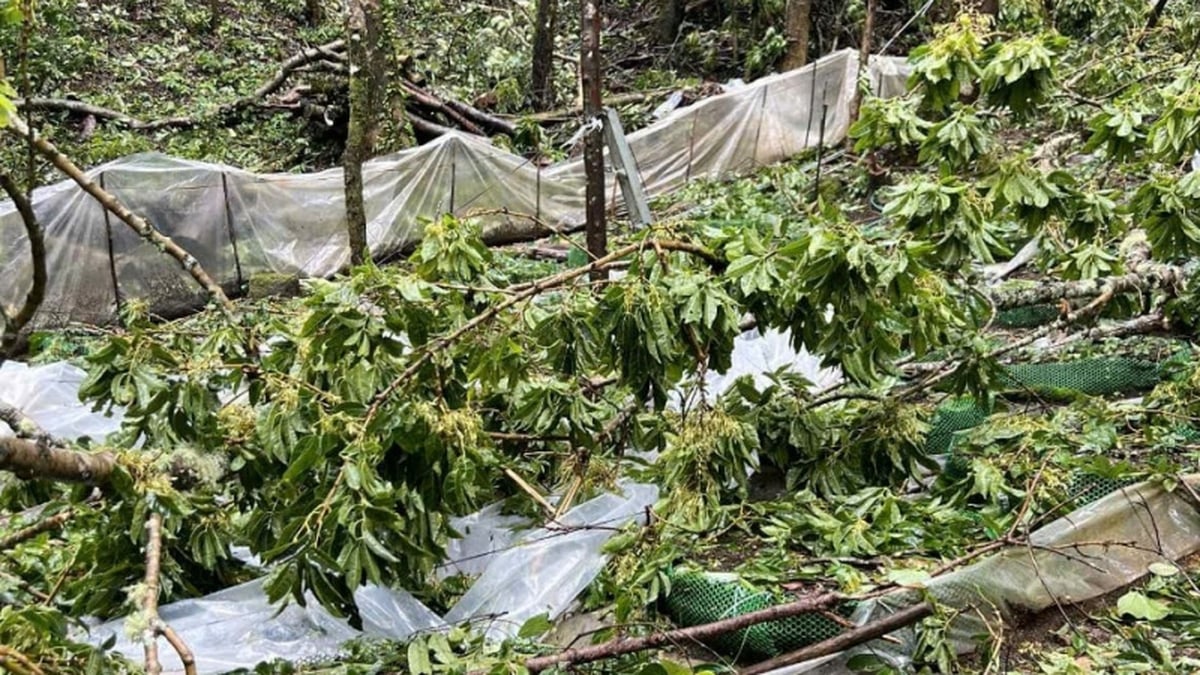The Jabugo meat processing facility is more than 100 years old: part modern office space, part historic farmhouse. Hundreds of hangers can be seen hanging hams outdoors as they are cured in a courtyard. These days, the pork is stored in a brick-walled cellar.
Sophisticated processing
The slaughtering takes place elsewhere. The 150-160kg pigs are strangled with CO2 gas, and when the veterinarian has determined that the animal is unconscious, a worker performs the bleeding. The legs, loins and shoulders are used to make Carvajal’s products, with the rest of the fresh meat sold to restaurants. The legs used to make the ham are then skinned, salted, washed, dried, and transferred to a storage cellar, where they remain for about a year and a half.
The 130-year-old Carvajal cellar is an underground ham warehouse. As you descend the stairs, you’re hit with a scent like stale bread, aged cheese and delicious cold cuts on the table, multiplied by the 40,000 hams inside.

The cellar is specially designed for processing and storing salted pork.
Thick brick walls, a cool, mountainous climate, and a stable, friendly microbiome are all it takes for a piece of pork to complete its journey to ham. Skilled professionals monitor the cellars, noting fluctuations in temperature and humidity, but their methods for adjusting parameters are surprisingly low-tech. Need to change the temperature? Open or close a window. Too dry? Pour some water on the floor.
Of course, getting the best ham is actually more complicated than that: hams left too close to the window can be discarded if they dry out too quickly, and pig feet are regularly rubbed with oil to keep insects from settling in – but to produce a ham, Carvajal ultimately has to rely on the skills of people, in this case, people with “professional” noses.
Before any ham leaves the cellar, it is “sniffed”. A trained nose can detect 100 aromas from a premium ham, some sweet, some meaty, some nutty. Different regions of Spain have their own ham standards, and even cuts from the same leg of pig have their own aromas.

5J brand pork legs
Only eight people are assigned to “smell” all the ham. The job is so specialized that one ham smeller, a third-generation Carvajal employee, is not qualified to smell the cured loin (another 5J product) because the smell is too distinct. That was his father’s job.
Using a short, stubby needle called a cala, the ham sniffer pokes down to the bone, quickly sniffs, and fills the puncture with a layer of fat. There is only a second or two to detect the balance of sweet, earthy, fermented aromas that signal a ham has been well cured and must pass the four-door smell test before it can leave the factory.
Even for ham-loving Spaniards, 5J ham is a luxury item, which is why Carvajal sells a more affordable ham under the Spanish-only label Sanchez Romero Carvajal. This ham is made from the same pigs and cured in the same cellars, just not kept under the same strict conditions as the premium variety. Only in the cellar do quality control experts decide which hams get the 5J label and which don’t.
From the cooking pit to the dining table
Even the way Iberico ham is eaten is special. It is not recommended to slice it by machine because the soft fat will flake off, and the skinny, bony legs make it difficult to slice horizontally. So when Carvajal sells a whole ham to a new restaurant or client, they will also “provide training” on how to slice the ham by hand.
The company also employs more than 60 skilled craftsmen to “carve” all of its pre-packaged hams. Like cutting fish for sushi in Japan, carving Spanish ham is a time-honored craft. The perfect slice is nearly transparent, small enough to eat in one bite, and cut at an even angle to produce the most consistent and efficient slices of ham possible.

Slicing ham is also an art.
Remember how expert ham smellers can detect four different aromas from the same ham? You may not be able to pick up all the nuances, but you can easily see that different cuts of ham have different looks and feels. A skilled butcher knows how to make the most of it all, mixing a plate of ham with different cuts to create contrast.
Old pig breed
Iberian ham, or jamón Ibérico, is one of the most expensive meats in the world . A leg of Iberico ham can cost as much as $4,500.
The Iberian pig is a descendant of the wild boar and has long been considered a delicacy. In 77 AD, the Roman writer Pliny the Elder praised the superior quality of the Iberian pig. In 1493, Christopher Columbus brought Iberian pigs with him on his second transatlantic voyage.

Iberico black pig
The black Iberian pig can be found in the southern and western regions of the Iberian Peninsula, including Spain and Portugal. In Spain, Iberian ham production is limited to the provinces of Salamanca, Huelva, Córdoba, Cáceres and Badajoz. Portugal also produces ham under the presunto Ibérico brand. Spanish Iberian ham is protected by the EU's Designation of Origin. Of the total Iberian ham production, only 6% is labeled black, indicating that it is 100% purebred black Iberian pig meat.
The untold secret of the most expensive pork in the world, more than 5 million VND for only 500g
Nguyen Xuan Thuy (Source: Serious eats; Business Insider)
Useful
Emotion
Creative
Unique
Source



































































































Comment (0)